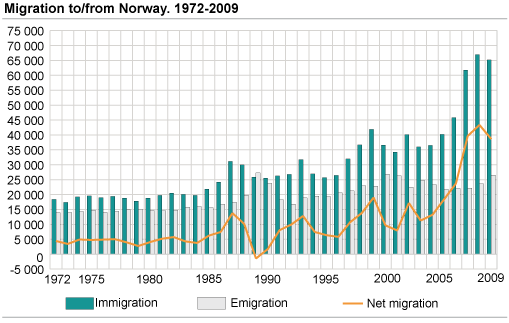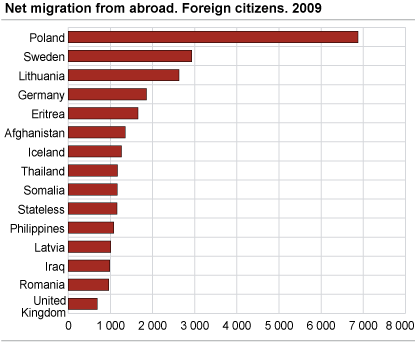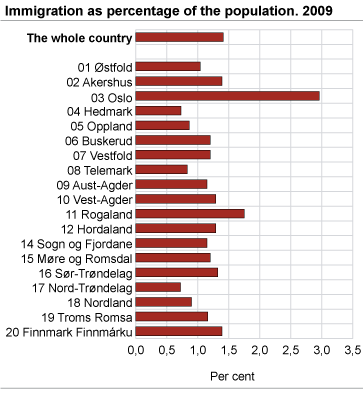Content
Published:
This is an archived release.
High immigration and emigration in 2009
In 2009, 65 200 immigrations and 26 550 emigrations were registered. This is the second highest immigration ever, and third highest emigration. Net immigration was 38 650; down 4 700 from the previous year, but the third highest ever registered.
Of the 56 700 immigrants having citizenship other than Norwegian, 32 700 or 58 per cent were citizens of EU member countries. Similar percentages could also be seen in the 1960s, but the share decreased and as late as in 2003 the share was 37 per cent, or 9 800 of 26 800 immigrants. Extensive immigration in previous years has been due to extraordinary situations resulting in large numbers of refugees, but at the moment, labour immigration from Poland, Sweden, Germany and Lithuania account for the high net immigration.
Europeans still dominate
Of the 36 500 European citizens who immigrated, Polish citizens made up the largest group (10 500), followed by Swedish (6 000) and Lithuanian citizens (3 200). Lithuanian citizens surpassed Germans as the third largest group. Some groups experienced a major increase, notably among these were Icelandic citizens, of whom 1 600 immigrated compared with 350 the previous year. Twice as many Latvian citizens (1 100) arrived than one year earlier. On the other hand, the number of Polish immigrants decreased from 14 400 in 2008 to 10 500 in 2009. The number of German immigrants also decreased, from 4 300 to 2 800. The number of immigrants from two refugee countries, Eritrea (1 700) and Afghanistan (1 400) doubled.
The immigration of African citizens was at around 3 000 towards the turn of the millennium, and then increased to around 4 000, before rising to 5 150 last year. From Asia, it has varied from 6 000 to 9 000 during recent years, before increasing to 10 300 in 2008 and 11 100 in 2009. From the Americas, it has varied in the last 20 years from 1 500 to 2 000, and has been at 2 400 the last two years.
High emigration
Of the 26 550 who emigrated, 18 400 were foreign citizens, which is the highest figure ever registered; 3 200 higher than the previous year and 6 000 higher than the average for the last 20 years. For the first time, Polish citizens made up the largest group with 3 600, followed by Swedish citizens with 3 100. The emigration of Polish citizens was three times as high as in 2007, when it reached 1 250. The change towards a lower immigration and higher emigration of above all Polish and German citizens started towards the end of 2008, at the beginning of the financial crisis, and was particularly noticeable during the first half of 2009.
Of the 3 600 Polish citizens who emigrated in 2009, 150 had immigrated during the same calendar year. The remainder had an average period of residence in Norway of one year and three months. A total of 3 200 or close to 90 per cent of them had immigrated in the 2007-2009 period. Of the 3 100 Swedish citizens who emigrated in 2009, 750 or one in every four had also immigrated in 2009. The remainder had an average period of residence of three years and five months. A total of 1 700 of the Norwegian citizens who emigrated were of immigrant origin, and these had lived in Norway for 14 years on average before they emigrated.
Polish citizens had the highest net immigration (immigration less emigration) with 6 900, but this was not far from only half of the 11 900 in 2008. They were followed by Swedish and Lithuanian citizens with 2 900 and 2 600 respectively. From 2003 to 2007, net immigration of Polish citizens increased from 300 to 12 900. This increase changes in 2008, when there was a decrease of 1 000, and in 2009 there was a further decrease of 5 000. This was due to 4 000 fewer Polish citizens arriving in 2009 than in 2008, and also to almost 1 100 more Polish citizens emigrating.
Where do they settle?
Oslo had the highest number of net immigration with 6 200, followed by Rogaland and Hordaland with 4 200 each, and Akershus with 3 600.
More than half of the net immigration by citizens from the new EU member countries - 5 400 out of 11 500 - took place in Oslo/Akershus and Rogaland/Hordaland. Swedish and Icelandic citizens settled in Oslo - 1 400 of a total net immigration of 4 200.
Only 16 out of the 430 municipalities saw no net immigration from abroad.
|
Total per 1000 of the population
(38 637 in all) (Norway = 8.2) |
Poland, Lithuania, Latvia and Romania
per 1 000 of the population (11 464 in all) (Norway = 2.4) |
Germany, France, Netherlands, United Kingdom and USA
per 1 000 of the population (3 578 in all) (Norway = 0.8) |
|||||||||||||||||||||||||||||||||||||||||||||||||||||||||||||||||||||||||||||
|---|---|---|---|---|---|---|---|---|---|---|---|---|---|---|---|---|---|---|---|---|---|---|---|---|---|---|---|---|---|---|---|---|---|---|---|---|---|---|---|---|---|---|---|---|---|---|---|---|---|---|---|---|---|---|---|---|---|---|---|---|---|---|---|---|---|---|---|---|---|---|---|---|---|---|---|---|---|---|---|
| 1 | Oslo | 11.1 | Sogn og Fjordane | 5.2 | Oslo | 1.3 | |||||||||||||||||||||||||||||||||||||||||||||||||||||||||||||||||||||||||
| 2 | Sogn og Fjordane | 11.0 | Møre og Romsdal | 4.8 | Rogaland | 1.2 | |||||||||||||||||||||||||||||||||||||||||||||||||||||||||||||||||||||||||
| 3 | Rogaland | 10.3 | Hordaland | 3.6 | Møre og Romsdal | 1.0 | |||||||||||||||||||||||||||||||||||||||||||||||||||||||||||||||||||||||||
|
Sweden and Iceland per 1000 of the population
(4 193 in all) (Norway = 0.9) |
Ethiopia, Eritrea, Somalia, Afghanistan, Burma, Iraq and Iran
per 1000 of the population (6 491 in all) (Norway = 1.4) |
Women from Filippines, Thailand, Brazil, Colombia and Russia
per 1000 of the population (2 623 in all) (Norway = 0.5) |
|||||||||||||||||||||||||||||||||||||||||||||||||||||||||||||||||||||||||||||
| 1 | Oslo | 2.5 | Troms Romsa | 3.6 | Finnmark Finnmárku | 1.0 | |||||||||||||||||||||||||||||||||||||||||||||||||||||||||||||||||||||||||
| 2 | Finnmark Finnmárku | 1.3 | Nordland | 2.4 | Oslo | 0.7 | |||||||||||||||||||||||||||||||||||||||||||||||||||||||||||||||||||||||||
| 3 | Rogaland | 1.0 | Finnmark Finnmárku / Sogn og Fjordane | 2.1 | Rogaland | 0.7 | |||||||||||||||||||||||||||||||||||||||||||||||||||||||||||||||||||||||||
Large share of Norwegian citizens
In total, 8 500 or 13 per cent of all immigrants were Norwegian citizens in 2009. Norwegian citizens account for a considerable share of the immigration from some countries. They may be students or professionals, or they live abroad for large parts of the year. A total of 8 200 Norwegian citizens emigrated, resulting in a net immigration of 300.
A total of 7 100 of the Norwegian citizens who immigrated were without immigrant origin. Of these, 1 500 immigrated from Sweden and 1 400 from Denmark, 700 from USA, 500 from the UK and 450 from Spain. Of the Norwegian citizens of immigrant origin who immigrated, the largest group (200) came from Pakistan.
A total of 6 200 of the Norwegian citizens who emigrated were without immigrant origin. Of these, 1 650 emigrated to Sweden and 1 600 to Denmark, 450 to USA, 400 to the UK and 300 to Spain. Of the Norwegian citizens of immigrant origin who emigrated, the largest group (300) left for the UK.
Tables:
- Table 1 Immigration and emigration. 1951-2009
- Table 2 Immigration/emigration, by county. 1966-2009
- Table 3 Immigration, by country. 1966-2009
- Table 4 Emigration, by country. 1966-2009
- Table 5 Net in-migration, by country. 1966-2009
- Table 6 Immigration and emigration, by sex, age and marital status of migrants. 2009
- Table 7 Immigration and emigration, by sex and age of migrants. 2009
- Table 8 Immigration, emigration and net immigration, by sex, age of migrants and county. 2009
- Table 9 Immigration and emigration, by citizenship, 2009
- Table 10 Immigration and emigration, by Norwegian/foreign citizenship and country of immigration/emigration. 2009
- Table 11 Immigration, by citizenship and region. 2009
- Table 12 Emigration, by citizenship and region. 2009
The statistics is published with Migrations.



